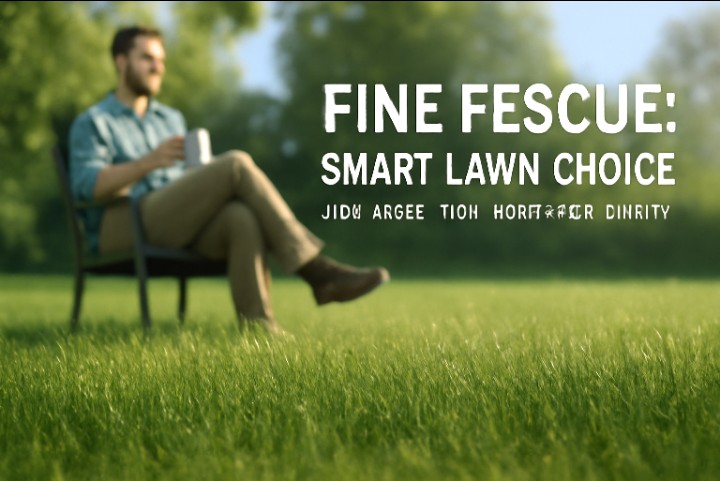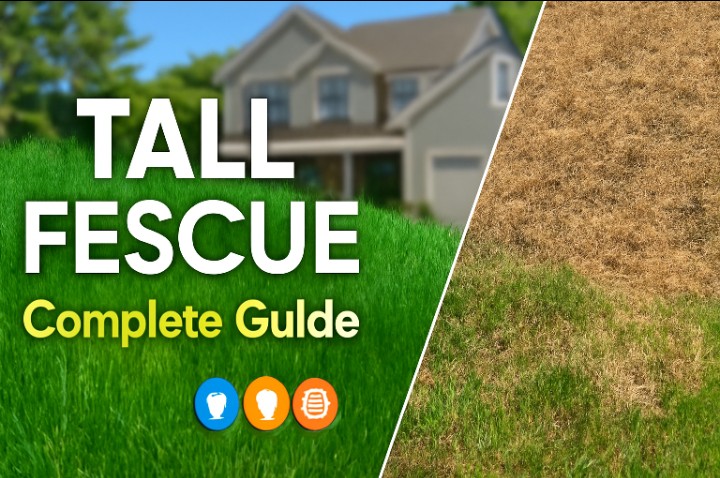Your lawn looks a bit tired lately? Walking on it feels spongy instead of firm? You might be dealing with thatch buildup. Don’t worry you are not alone in this battle.
Thousands of homeowners across Western cities face this issue every season. Professional lawn services charge between $65-$160 for dethatching but you can tackle this yourself with the right knowledge.
What Exactly is Lawn Thatch?
Just Imagine, you are looking at your grass from the side. Thatch is the layer of organic matter that develops between the grass and the soil. It is made up of dead grass stems, roots and other organic debris that have not decomposed yet.
Here is the thing, a little thatch is actually good. A thin layer of thatch is good for your lawn but too much can kill grass. It acts like a natural cushion and helps retain moisture.
But when thatch gets too thick, it becomes your lawn’s enemy. Water and nutrients can not reach the soil. Your grass starts struggling to survive.
Signs Your Lawn Needs Dethatching
Your lawn will tell you when it’s time to act. Here are the warning signs to watch for:
The Spongy Test: Walk across your lawn. Spongy, browning grass riddled with pests or disease may be a sign your lawn has too much thatch. If it feels like walking on a mattress you have got problems.
Visual Inspection: Look for bare patches where grass is dying. Poor color and weak growth are red flags. When your once-green lawn looks patchy and thin, thatch might be choking it.
The Simple Check: Want to know for sure? Cut a small section of turf with a trowel. Look for the brown layer between grass and soil. If it is thicker than half an inch, it’s time to dethatch.
When to Dethatch Your Lawn
Timing is everything here. Get it wrong and you will stress your grass even more.
Cool-Season Grasses (Kentucky Bluegrass, Fescue)
Dethatch cool-season grasses, such as Kentucky bluegrass in late summer or early fall. Think August through September in places like Michigan. Dethatch your Michigan lawn in between August 20 to September 30.
Spring works too but fall is better. The best time to dethatch a cool-season lawn is late summer to early fall starting in August. Your grass has time to recover before winter hits.
Warm-Season Grasses (Bermuda, Zoysia, St. Augustine)
Dethatch warm-season grasses such as Bermudagrass or Zoysia grass, after spring green-up as they enter early summer’s peak growth. Late spring to early summer is your sweet spot.
In Texas, this means late spring. For warm season-grasses, late spring is your go-to time. Wait until nights are warm and grass is growing strong.
Weather Matters Too
The best time to dethatch your lawn is when it is actively growing and the soil is moderately moist. Don not dethatch during drought or extreme heat. Your grass needs energy to recover.
Skip dethatching if your lawn is stressed. Dormant grass will not bounce back quickly from this aggressive treatment.
How to Dethatch Your Lawn
Ready to get your hands dirty? Here is how to do it right.
Getting Started
Mow your lawn first. Set your mower to its lowest setting. This gives you better access to the thatch layer. Check that soil is moderately moist – not soggy not bone dry.
Manual Method (Best for Smaller Yards)
You will need a dethatching rake. These have thick, perpendicular metal tines designed to dig deep. The True Temper Thatch Rake is a popular choice among homeowners.
Here is the technique, Apply significant downward pressure. This is not like raking leaves. Dig those tines into the thatch and pull toward you. Work in one direction across your lawn. You will rip up tangled brown material that is the thatch coming out.
It’s hard work but effective for small to medium lawns.
Power Tool Options
Got a larger yard? Power tools save time and energy.
Power Rake: Look for models with 12-amp motors like the Worx WG850. These have 14-inch cutting paths and spring tines. Most offer three depth settings and collection bags for debris.
Vertical Mower: More aggressive than power rakes. These have rotating vertical blades that cut through thick thatch. Sun Joe makes reliable models for homeowners.
Professional vs DIY
Small yards work fine with manual tools. Larger properties benefit from power equipment or professional service. You can hire a lawn service to dethatch your lawn for you if the job feels overwhelming.
Consider your time investment. Plan for several hours of work especially with manual tools.
After Dethatching Care
Your lawn will look rough after dethatching that’s normal. Here is how to help it recover:
Clean up all the debris you have pulled up. Your yard will be covered in brown thatch material. Rake it up and compost it or bag it for pickup.
Water carefully. If you are planning to overseed, hold off on watering until after you spread seed. Otherwise, give your lawn a good drink to help recovery.
Expect your lawn to look stressed for a few weeks. This is normal recovery time. Watch for new growth that’s your sign the process worked.
Tool Selection Guide for 2025
Manual Options
The True Temper Adjustable Thatch Rake remains top-rated. It has a two-sided head and adjustable tines. Perfect for homeowners with small to medium lawns who don’t mind the workout.
Power Options
Walk-behind units with spring tines are most popular. Look for compact designs with fold-down handles for easier storage. The best 2025 models offer variable speed and depth control.
Cost Breakdown
Professional Service
Hiring a lawn service costs $65-$160 depending on your location and lawn size. Urban areas typically cost more than suburban zones.
DIY Costs
Manual rakes run $30-$80 for quality models. Power dethatchers range from $150-$400 to buy or $40-$80 per day to rent. For occasional use, renting makes more sense.
Preventing Future Thatch Problems
Prevention beats cure every time. Regular lawn maintenance reduces thatch buildup. Excessive thatch can make your lawn more susceptible to disease, insects and drought. It can be controlled by prevention and removal.
Avoid over-fertilizing with nitrogen. Too much nitrogen creates rapid growth and more organic matter than your soil can decompose. Water deeply but less frequently to encourage strong root growth.
Core aeration helps too. It improves soil conditions that help organic matter break down naturally.
Long-term Lawn Health
Proper dethatching transforms struggling lawns. Water and nutrients reach grass roots again. Your lawn becomes more resistant to pests and diseases. The result? Thicker, greener grass that neighbors will envy.
Common Dethatching Mistakes to Avoid
Even experienced homeowners make costly errors. According to Bryan Clayton, CEO of GreenPal, common mistakes include dethatching at the wrong time, neglecting cleanup or dethatching when you should do something else instead.
One major mistake is jumping straight into dethatching without checking thatch thickness. Many homeowners assume they need dethatching just because grass looks poor. Always test first with the trowel method.
Another error? Spring dethatching hits dormant lawns when they are already struggling from winter damage. This timing can destroy grass instead of helping it.
Wrong equipment causes problems too. Using inadequate tools leads to incomplete thatch removal and uneven results. Vertical mowers can damage nearby vegetation if not handled properly.
Don’t skip the cleanup either. After dethatching your lawn will look ragged. All that loose thatch needs removal or it blocks sunlight from reaching new growth.
Should You Overseed After Dethatching?
Dethatching creates perfect conditions for new grass. If your lawn wasn’t dense before dethatching, overseeding immediately after is a great option. The loosened soil and open spaces help seeds germinate.
Overseeding after dethatching helps fill bare patches and promotes thicker more resilient lawns. It is especially helpful if dethatching created some bare spots.
Here is the process Mow existing grass to one inch or shorter before spreading seed. This gives seeds better soil contact. Keep the top half-inch of soil consistently moist with light waterings 2-3 times daily.
Timing fertilizer matters. Wait about a week after germination before fertilizing. Early fertilizer makes existing grass grow faster, crowding out new seedlings.
Equipment Transport and Safety
Power dethatchers are heavy machines. You will need a truck and friends to help load and unload equipment. Most rental places will help you load but you are on your own at home.
Make sure lawn is slightly moist but not wet before starting. Rock-hard soil resists penetration. Soggy soil creates a muddy mess.
Follow manufacturer instructions carefully. Go over your lawn once like mowing. Multiple passes can damage grass roots.
Alternative Uses for Removed Thatch
Don’t waste the thatch you remove. You can compost it or use it as mulch around trees and shrubs. Just make sure it has not been treated with herbicides or chemicals that could harm plants.
Composted thatch becomes excellent soil amendment. Mix it with other organic matter for a nutrient-rich addition to garden beds.
The End
Dethatching might seem intimidating but it is really straightforward. The best time to dethatch your lawn is when the grass is in an active growth period and there is adequate soil moisture. Choose your timing based on grass type and local conditions.
Start small if you are unsure. Try a manual rake on a test area first. See how your grass responds before tackling the entire lawn.
Remember, too much thatch can kill grass. But with proper timing and technique, dethatching revitalizes tired lawns. Your grass will thank you with healthier more vibrant growth.
Still feeling uncertain? Consider consulting a local lawn care professional. They can assess your specific situation and recommend the best approach for your Western city climate and grass type.






